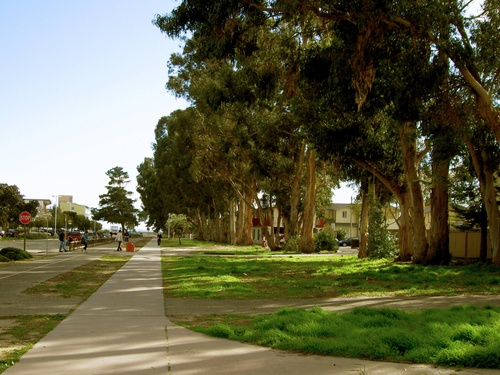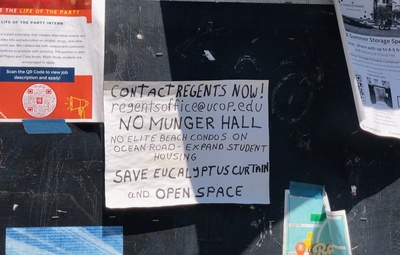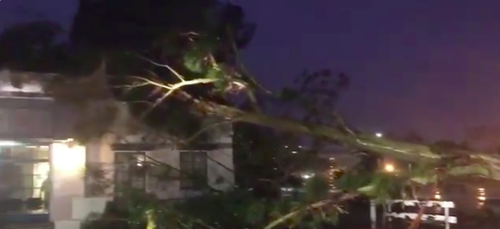 February 2007, by Britta Gustafson (CC BY-SA)
February 2007, by Britta Gustafson (CC BY-SA)
The Eucalyptus Curtain is the tall row of eucalyptus trees that marks the border between UCSB and Isla Vista. It may have been planted in the late 1800s as a wind break between two ranches (although maybe planted a decade or two later). About 19 of the trees are scheduled to be removed, starting in late summer 2023, for the construction of faculty housing.
Natural history
Eucalyptus trees are part of the ecosystem here, but not a native species. From "Goleta, the Bad Land" by Darwin BondGraham: "Imported into North America by Ellwood Cooper and several other entrepreneurs in the 1860s, the tree was designed to solve several major problems for this first generation of pioneers. A rancher who owned much of the present day area know as “Ellwood,” Cooper brought in many varieties of eucalyptus and helped establish the trees widely up and down the west coast...The “eucalyptus curtain,” that separates Isla Vista from the UCSB campus was planted as a wind break and line of demarcation between two of Den's children who each inherited parcels from his original land grant."
Tom Modugno tells more of the story at Goleta History: "[Ellwood Cooper] became convinced that Blue Gum Eucalyptus trees could be a reliable lumber source that grew well in our climate. He imported them from Australia and planted a thick grove where Ellwood School is today. He wasn’t the first in California to plant Eucalyptus, but he was the first to grow them on a large scale for the market. Unfortunately, they rotted in salt water and underground, making them useless as pier pilings or telegraph poles. Additionally, it couldn’t be milled into lumber because of it’s coarse grains and when it was dry it was very difficult to saw or split. So it’s only real value was as a windbreak."
In the Ellwood neighborhood next to IV, migrating monarch butterflies rest in those eucalyptus trees, which the City of Goleta manages as a tourist attraction: Goleta (Ellwood Main) Butterfly Grove.
Proposed removal as part of UCSB's Ocean Road Housing Project
 Aerial view of this border in 1928 - it's hard to tell how tall the trees were then. (From the UCSB Special Collections Library.)
Aerial view of this border in 1928 - it's hard to tell how tall the trees were then. (From the UCSB Special Collections Library.)
As announced in 2005, UCSB has been discussing and planning the construction of an Ocean Road project that would remove these trees and replace them with 500+ units of housing for faculty and staff. This is controversial for many reasons, including that many people don't want the trees to be destroyed.
It was part of the Long Range Development Plan and is now part of the longer-term "Vision 2025" plan because of process-related concerns from advocacy groups and local government officials as well as concerns about gentrification and sustainability. A drawing of the plan is available here (bigger version).
UCSB has seen the trees as preventing a good relationship between campus and IV ("The current Pardall tunnel and Eucalyptus Curtain provide graphic evidence of the barrier between the campus and community", from this article), and others have used the trees as a metaphor for the relationship ("Yang’s ability to hide behind the eucalyptus curtain"). The university believes building this housing complex would smooth things out.
This project is part of UCSB's "A Call for Action" document published in November 2014: "Work to make Isla Vista attractive to a broad range of people by developing approximately 500 units of faculty housing along Ocean Road and incentivizing property owners to diversify the retail and amenity offerings to include quality cafes with adult dining and evening entertainment suitable for all ages."
A December 2013 document by the California Coastal Commission says that 17 eucalyptus trees, 1 live oak tree, and 1 Monterey cypress tree will be removed as part of this project, along with pruning 102 trees. It says the trees are "...87 to 97 years old with many of them exceeding 100 feet in height. Additionally, some of these trees are approaching the end of their lifespan and some of which have been determined to be unhealthy and unsafe to person and property in the vicinity of the eucalyptus windrow. The arborist report recommends removal of the 19 subject trees due to disease, poor structure, crowding, and tree and site conditions that lend themselves to long-term instability."
In June 2022, UCSB announced that the UC Board of Regents had approved the Ocean Road workforce housing project, and "groundbreaking is anticipated begin in the summer of 2023, with the first for-sale units coming online in mid to late 2024". It described 540 units: 360 for rent and 180 for sale. A leader of the project team expected a positive impact on IV: “With a larger year-round population, the mix of business out there could change, as could some of the older apartment complexes. It could be transformational not only for Isla Vista but for the campus itself. There will be a significant permanent resident population on campus for the first time.”
In the Nexus in August 2022, a couple professors said they'd like to see these non-native trees replaced with a grove of native oak trees.
 Local bulletin board in June 2023; by Britta Gustafson (CC BY-SA)
Local bulletin board in June 2023; by Britta Gustafson (CC BY-SA)
Damage to the IV Foot Patrol building
On a rainy and windy night in February 2019, one of the trees fell on top of the Isla Vista Foot Patrol building.
 Screenshot from a video by the SB Sheriff's Office
Screenshot from a video by the SB Sheriff's Office


